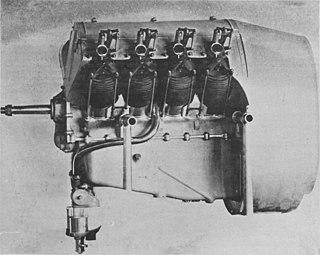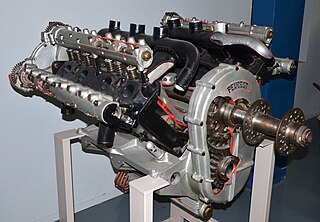
The Hispano-Suiza 12Y was an aircraft engine produced by Hispano-Suiza for the French Air Force before the Second World War. The 12Y became the primary French 1,000 hp (750 kW) class engine and was used in a number of famous aircraft, including the Morane-Saulnier M.S.406 and Dewoitine D.520.

The Breguet XIV or Breguet 14 was a French biplane bomber and reconnaissance aircraft of World War I. It was built in very large numbers and production continued for many years after the end of the war.
The Latécoère 14 and Latécoère 16 were similar French passenger and postal aircraft of advanced design built in 1923. They differed chiefly in engine power. Only one of each was constructed. The 14's type number was reused for an unrelated parasol wing prototype that was basis of the more successful Latécoère 17.

The Latécoère 17 was a French airliner built in 1923 for use on Latécoère's own airline routes between France and Morocco. The prototype was designated the Latécoère 14, reusing the number of an unrelated earlier design that had been rejected. This new aircraft was a parasol wing monoplane of conventional configuration with an enclosed cabin for four passengers and an open cockpit for the pilot. This was Latécoère's first commercially successful design and as production continued, three different engines were fitted.

The Continental IO-550 engine is a large family of 9 liter fuel injected six-cylinder, horizontally opposed, air-cooled aircraft engines that were developed for use in light aircraft by Teledyne Continental Motors. The first IO-550 was delivered in 1983 and the type remains in production.

The Renault 70 hp, was a French V-8 aero engine that first ran in 1910. The type powered many early military aircraft including the Farman MF.7 Longhorn and the Royal Aircraft Factory B.E.2. In addition to French production, these engines were also built in the United Kingdom and equipped the majority of British aircraft sent to France at the start of WW1.

The Renault 80 hp, or 8Ca, or Type WS is a development of the Renault 70 hp V-8 aero engine that was produced exclusively in the Unted Kingdom by Renault's British subsidiary, and its licensees, from 1913 to 1918.

The Salmson water-cooled aero-engines, produced in France by Société des Moteurs Salmson from 1908 until 1920, were a series of pioneering aero-engines: unusually combining water-cooling with the radial arrangement of their cylinders.
The Hispano-Suiza 12N was one of two new V-12 engine designs first run in 1928 and was manufactured by Hispano-Suiza's French subsidiary for the Armee d'l'Air. It produced about 485 kW (650 hp), was the first to use gas nitride hardening and introduced wet cylinder liners into Hispano-Suiza's aircraft engine range. It powered the first non-stop flight from Europe to the United States.
The Renault 6P, also called the Renault Bengali, was a series of air-cooled 6-cylinder inverted in-line aero engines designed and built in France from the late 1920s, which produced from 130 kW (180 hp) to 200 kW (270 hp).
The Breguet Colibri was a low power, single seat French monoplane designed to compete in a 1923 newspaper-sponsored contest between such aircraft. Only one was built.

The Lorraine 12D, also referred to as Lorraine-Dietrich 12D, was a series of water-cooled V12 engines produced by the French company Lorraine-Dietrich. The first variant began production in 1917, and the engines were used to power bombers for the French Navy during World War I. The Lorraine 12Da variant was the most powerful French engine at the time. After the war, the engines were licensed and produced by the Italian firm Isotta Fraschini until 1925.

The Renault 12R was an air-cooled inverted V12 aircraft engine developed by the French engineering company Renault in the 1930s. The design was based on mounting two 6Q six-cylinder engines on a single crankshaft. In production, the engine was rated between 450 and 500 hp, although a high performance version built for the sole Caudron C.712 racing special produced 730 hp (540 kW). More than one third of production went to power the Caudron C.714 light fighter that fought in the early stages of World War II for the French and Polish Air Forces.

The Renault 130 hp V-12 aircraft engine is a twelve-cylinder, air cooled 90° vee engine built by the French Renault company.

The De Dion-Bouton 78 hp, typically referred to as De Dion-Bouton 80 hp, was an eight-cylinder, air cooled vee aircraft engine that has been built by De Dion-Bouton.

The De Dion-Bouton 130 hp aircraft engine, also referred to as De Dion-Bouton 12B, was a twelve-cylinder, air cooled vee aircraft engine that has been built by De Dion-Bouton.

The Renault 50/60 hp aircraft engines were a series of air cooled 90° V-8 engines with a bore and stroke of 90 mm × 120 mm built by the French Renault company in the years from 1908 to about 1911.

The Renault 90 hp, or 12A, was the world’s first V12 aircraft engine. The engine was developed in 1911 from Renault’s earlier V8 engines and used the same air-cooled design.

The Renault 12F is a family of liquid-cooled 22 L (1,300 cu in) 50 deg V12 aircraft engines that saw widespread use during WW1 and the 1920s.

The Peugeot 8Aa, or L112, is a water-cooled V8 aircraft engine that equipped the 1,123 Voisin VIII bombers and fighters built during WW1. The 8Aa was the first engine designed by Peugeot for airplane use and the only one that saw service in WW1. In publications the engine is often referred to as the Peugeot 200 hp, or 220 hp. Voisin VIIIs formed the bulk of the French night bomber force through 1916-17 before being replaced in front line service by the Voisin X which was fitted with the more powerful and reliable Renault 12Fe.

















